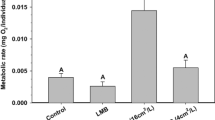Abstract
The objective of the present study was to analyze the effect of chronic cadmium (Cd) exposure at two alkalinity levels (63 and 92 mg l−1 CaCO3) on the antipredatory behavior of juvenile silver catfish (Rhamdia quelen) exposed to conspecific skin extract and predator odor. At an alkalinity of 63 mg l−1 CaCO3, 30 days of exposure to either 4.5 or 8.0 μg l−1 Cd impaired the catfish’s antipredatory response to alarm cues. However, silver catfish exposed to 4.5 μg l−1 Cd at an alkalinity of 92 mg l−1 CaCO3 responded to skin extract and predator odor. In catfish exposed to 8.0 μg l−1 Cd at the same alkalinity, only the number of feeding bites decreased, and this occurred only for specimens exposed to predator odor. Our results show that higher alkalinity protected against the deleterious effects of Cd on alarm cue detection but only in the larvae exposed to the lowest waterborne Cd level.
Similar content being viewed by others
References
Baker CF, Montgomery JC (2001) Sensory deficits induced by cadmium in banded kokopu, Galaxias fasciatus, juveniles. Environ Biol Fish 62:455–464. doi:10.1023/A:1012290912326
Baldisserotto B, Kamunde C, Wood CM (2004) A protective effect of dietary calcium against acute waterborne cadmium uptake in rainbow trout. Aquat Toxicol 67:57–73. doi:10.1016/j.aquatox.2003.12.004
Benaduce APS, Kochhann D, Flores EMM, Dressler VL, Baldisserotto B (2008) Toxicity of cadmium for silver catfish Rhamdia quelen embryos and larvae at different alkalinities. Arch Environ Contam Toxicol 54:274–282. doi:10.1007/s00244-007-9024-2
Berejikian BA, Tezak EP, LaRae AL (2003) Innate and enhanced predator recognition in hatchery-reared chinook salmon. Environ Biol Fish 67:241–251. doi:10.1023/A:1025887015436
Boyd CE, Tucker CS (1992) Water quality and pond soil analyses for aquaculture. Alabama Agricultural Experimental Station, Auburn University, Auburn, AL
Brown GE, Dreier VM (2002) Predator inspection behaviour and attack cone avoidance in a characin fish: the effects of predator diet and prey experience. Anim Behav 63:1175–1181. doi:10.1006/anbe.2002.3024
Brown GE, Smith RJF (1997) Conspecific skin extracts elicit antipredator responses in juvenile rainbow trout (Oncorhynchus mykiss). Can J Zool 75:1916–1922. doi:10.1139/z97-821
Brown GE, Smith RJF (1998) Acquired predator recognition in juvenile rainbow trout (Oncorhynchus mykiss): Conditioning hatchery reared fish to recognize chemical cues of a predator. Can J Fish Aquat Sci 55:611–617. doi:10.1139/cjfas-55-3-611
Burks RL, Lodge DM (2002) Cued in: advances and opportunities in freshwater chemical ecology. J Chem Ecol 28:1901–1917. doi:10.1023/A:1020785525081
Chivers DP, Smith RJF (1993) The role of olfaction in chemosensory-based predator recognition in the fathead minnow, Pimephales promelas. J Chem Ecol 19:623–633. doi:10.1007/BF00984997
Chivers DP, Smith RJF (1994) The role of experience and chemical alarm signaling in predator recognition by fathead minnows, Pimephales promelas. J Fish Biol 44:273–285. doi:10.1111/j.1095-8649.1994.tb01205.x
Chivers DP, Smith RJF (1995) Free-living minnows (Pimephales promelas) rapidly learn to recognize pike (Esox Lucius) as predators. J Fish Biol 46:949–954. doi:10.1111/j.1095-8649.1995.tb01399.x
Chivers DP, Smith RJF (1998) Chemical alarm signaling in aquatic predator-prey systems: A review and prospectus. Ecoscience 5:338–352
Davies PH, Gorman WC, Carlson CA, Brinkman SF (1993) Effect of hardness on bioavailability and toxicity of cadmium to rainbow trout. Chem Speciat Bioavail 5:67–76
Greenberg AE, Taras MJ, Rand MC (1976) Standard methods for the examination of water and wastewater, vol 14. Bru-El Graphic Inc., Springfield
Gustafsson JP (2004) Visual Minteq 2.23. Department of Land and Water Resources Engineering, Royal Institute of Technology, Stockholm, Sweden
Hansen JA, Welsh PG, Lipton J, Cacela D, Dailey AD (2002) Relative sensitivity of bull trout (Salvelinus confluentus) and rainbow trout (Oncorhynchus mykiss) to acute exposures of cadmium and zinc. Environ Toxicol Chem 21:67–75. doi:10.1897/1551-5028(2002)021<0067:RSOBTS>2.0.CO;2
Hara TJ (1994) The diversity of chemical stimulation in fish olfaction and gustation. Rev Fish Biol Fish 4:1–35. doi:10.1007/BF00043259
Hollis L, Hogstrand C, Wood CM (2001) Tissue-specific cadmium accumulation, metallothionein induction, and tissue zinc and copper levels during chronic sublethal cadmium exposure in juvenile rainbow trout. Arch Environ Contam Toxicol 41:468–474. doi:10.1007/s002440010273
Hollis L, McGeer JC, McDonald DG, Wood CM (2000) Protective effects of calcium against chronic waterborne cadmium exposure in juvenile rainbow trout. Environ Toxicol Chem 19:2725–2734.
Honda RT, Fernandes-de-Castilho M, Val AL (2008) Cadmium-induced disruption of environmental exploration and chemical communication in matrinxã, Brycon amazonicus. Aquat Toxicol 89:204–206. doi:10.1016/j.aquatox.2008.07.001
Korpi NL, Wisenden BD (2001) Learned recognition of novel predator odour by zebra danios, Danio rerio, following time-shifted presentation of alarm cue and predator odour. Environ Biol Fish 61:205–211. doi:10.1023/A:1011091426030
Leduc AOHC, Ferrari MCO, Kelly JM, Brown GE (2004) Learning to recognize novel predators under weakly acidic conditions: The effect of reduced pH on acquired predator recognition by juvenile rainbow trout. Chemoecology 14:107–112. doi:10.1007/s00049-003-0268-7
Lima SL, Dill LM (1990) Behavioural decisions made under the risk of predation: A review and prospectus. Can J Zool 68:619–640. doi:10.1139/z90-092
Lopes JM, Silva LVF, Baldisserotto B (2001) Survival and growth of silver catfish larvae exposed to different water pH. Aquac Int 9:73–80. doi:10.1023/A:1012512211898
Mathis A, Smith RJF (1993) Fathead minnows, Pimephales promelas, learn to recognize northern pike, Esox lucius, as predator on the basis of chemical stimuli from minnows in the pike’s diet. Anim Behav 46:645–656. doi:10.1006/anbe.1993.1241
McGeer JC, Szebedinszky C, McDonald DG, Wood CM (2000) Effects of chronic sublethal exposure to waterborne Cu, Cd or Zn in rainbow trout 2: Tissue specific metal accumulation. Aquat Toxicol 50:245–256. doi:10.1016/S0166-445X(99)00106-X
Meinelt T, Playle RC, Pietrock M, Burnison BK, Wienke A, Steinberg CEW (2001) Interaction of cadmium toxicity in embryos and larvae of zebrafish (Danio rerio) with calcium and humic substances. Aquat Toxicol 54:205–215. doi:10.1016/S0166-445X(01)00145-X
Mirza RS, Chivers DP (2001) Are chemical alarm cues conserved within salmonid fishes? J Chem Ecol 27:1641–1655. doi:10.1023/A:1010414426082
Mirza RS, Chivers DP (2003) Fathead minnows learn to recognize heterospecific alarm cues they detect in the diet of a know predator. Behaviour 140:1359–1369. doi:10.1163/156853903771980620
Pereira GS, Pereira ME, Weibezahn F (1982) Contribución al conocimiento de la ecología alimentaría de algunos peces del lago Valencia (Venezuela). Memorias de la Sociedad de Ciencias Naturales La Salle 17:41–56
Piper RG, McElwain IB, Orme LE, McCraren JP, Fowler LG, Leonard JR (1982) Fish hatchery management. United States Department of the Interior, Fish and Wildlife Service, Washington, DC
Richards JG, Playle RC (1999) Protective effects of calcium against the physiological effects of exposure to a combination of cadmium and copper in rainbow trout (Oncorhyncus mykiss). Can J Zool 77:1035–1047. doi:10.1139/cjz-77-7-1035
Scott GR, Sloman KA (2004) The effects of environmental pollutants on complex fish behaviour: Integrating behavioural and physiological indicators of toxicity. Aquat Toxicol 68:369–392. doi:10.1016/j.aquatox.2004.03.016
Scott GR, Sloman KA, Rouleau C, Wood CM (2003) Cadmium disrupts behavioural and physiological responses to alarm substance in juvenile rainbow trout (Oncorhynchus mykiss). J Exp Biol 206:1779–1790. doi:10.1242/jeb.00353
Sloman KA, Scott GR, Diao Z, Rouleau C, Wood CM, McDonald DG (2003) Cadmium affects the social behaviour of rainbow trout, Oncorhynchus mykiss. Aquat Toxicol 65:171–185. doi:10.1016/S0166-445X(03)00122-X
Smith RJF (1992) Alarm signals in fishes. Rev Fish Biol Fish 2:33–63. doi:10.1007/BF00042916
Sullivan JF, Atchison GJ, Kolar DJ, McIntosh AW (1978) Changes in the predator-prey behaviour of fathead minnows (Pimephales promelas) and largemouth bass (Micropterus salmoides) caused by cadmium. J Fish Res Board Can 35:446–451
Szebedinszky C, McGeer JC, McDonald DG, Wood CM (2001) Effects of chronic Cd exposure via diet or water on internal organs-specific distribution and subsequent gill Cd uptake kinetics in juvenile rainbow trout (Onkorhynchus mykiss). Environ Toxicol Chem 20:597–607. doi:10.1897/1551-5028(2001)020<0597:EOCCEV>2.0.CO;2
Wood CM (2001) Toxic responses of the gill. In: Schlenk DW, Benson WH (eds) Target organ toxicity in marine and freshwater teleosts. Vol 1—organs. Taylor and Francis, New York, NY, pp 1–89
Acknowledgments
The authors thank Richard P. Brinn, from Florida International University, for critical review of the manuscript. B. Baldisserotto and D. Kochhann, respectively, received research and undergraduate fellowships from Conselho Nacional de Desenvolvimento Tecnológico. The authors are also thankful to Coordenação de Aperfeiçoamento de Pessoal de Nível Superior for financial support.
Author information
Authors and Affiliations
Corresponding author
Rights and permissions
About this article
Cite this article
Kochhann, D., Benaduce, A.P.S., Copatti, C.E. et al. Protective Effect of High Alkalinity Against the Deleterious Effects of Chronic Waterborne Cadmium Exposure on the Detection of Alarm Cues by Juvenile Silver Catfish (Rhamdia quelen). Arch Environ Contam Toxicol 56, 770–775 (2009). https://doi.org/10.1007/s00244-009-9291-1
Received:
Accepted:
Published:
Issue Date:
DOI: https://doi.org/10.1007/s00244-009-9291-1




